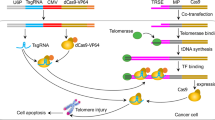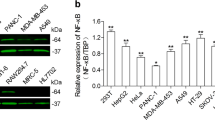Abstract
A major goal in cancer gene therapy is to develop efficient gene transfer protocols that allow tissue-specific and tightly regulated expression of therapeutic genes. The ideal vector should efficiently transduce cancer cells with minimal toxicity on normal tissues and persistently express foreign genes. One of the most promising regulatory systems is the mifepristone/RU486-regulated system, which has much lower basal transcriptional activity and high inducibility. In this work, we modified this system by incorporating a cancer-specific promoter, the human telomerase reverse transcriptase (hTERT) promoter. By utilizing hTERT promoter to control the regulator, RU486 could specifically induce the expression of foreign genes in cancer cells but not in normal cells. In the context of this system, a dominant negative mutant of survivin (surDN) was controllably expressed in colorectal tumor cells. The surDN expression induced by RU486 showed a dosage- and time-dependent pattern. Regulated expression of surDN caused caspase-dependent apoptosis in colorectal tumor cells but had little effect on normal cells. Analysis of cell viability showed that RU486-induced expression of surDN suppressed colorectal tumor cell growth and had synergic effect in combination with chemotherapeutic agents. The potential of this system in cancer therapy was evaluated in experimental animals. Tumor xenograft models were established in nude mice with colorectal tumor cells, and RU486 was intraperitoneally administered. The results showed that conditional expression of surDN efficiently inhibited tumor growth in vivo and prolonged the life of tumor-burdened mice. Synergized with the chemotherapeutic drug cisplatin, regulated surDN expression completely suppressed tumor growth. These results indicated that this modified RU486-regulated system could be useful in cancer-targeting therapy.





Similar content being viewed by others
Abbreviations
- hTERT:
-
human telomerase reverse transcriptase
- SurDN:
-
survivin dominant negative mutant
- GAL4 UAS17-mer :
-
17-mer GAL4 upstream activation sequence
References
Wang Y, O’Malley BW Jr, Tsai SY, O’Malley BW (1994) A regulatory system for use in gene transfer. Proc Natl Acad Sci USA 91:8180–8184
Burcin MM, O’Malley BW, Tsai SY (1998) A regulatory system for target gene expression. Front Biosci 3:c1–c7
Yaolin Wang, O’Malley BW, SY Tsai (1997) Inducible system designed for future gene therapy. Method Mol Med 63:401–413
Wang Y, Xu J, Pierson T, O’Malley BW, Tsai SY (1997) Positive and negative regulation of gene expression in eukaryotic cells with an inducible transcriptional regulator. Gene Ther 4:432–441
Hanahan D, Weinberg RA (2000) The hallmarks of cancer. Cell 100:57–70
Thornberry NA, Lazebnik Y (1998) Caspases: enemies within. Science 281:1312–1316
Reed JC (1999) Dysregulation of apoptosis in cancer. J Clin Oncol 17:2941–2953
Danial NN, Korsmeyer SJ (2004) Cell death: critical control points. Cell 116:205–219
Cory S, Adams JM (2002) The Bcl2 family: regulators of the cellular life-or-death switch. Nat Rev Cancer 2:647–656
Salvesen GS, Duckett CS (2002) IAP proteins: blocking the road to death’s door. Nat Rev Mol Cell Biol 3:401–410
Ambrosini G, Adida C, Altieri DC (1997) A novel anti-apoptosis gene, survivin, expressed in cancer and lymphoma. Nat Med 3:917–921
Altieri DC, Marchisio PC, Marchisio C (1999) Survivin apoptosis: an interloper between cell death and cell proliferation in cancer. Lab Invest 79:1327–1333
Altieri DC (2003) Validating survivin as a cancer therapeutic target. Nat Rev Cancer 3:46–54
Jiang X, Wilford C, Duensing S, Munger K, Jones G, Jones D (2001) Participation of Survivin in mitotic and apoptotic activities of normal and tumor-derived cells. J Cell Biochem 83:342–354
Ambrosini G, Adida C, Sirugo G, Altieri DC (1998) Induction of apoptosis and inhibition of cell proliferation by survivin gene targeting. J Biol Chem 273:11177–11182
Olie RA et al (2000) A novel antisense oligonucleotide targeting survivin expression induces apoptosis and sensitizes lung cancer cells to chemotherapy. Cancer Res 60:2805–2809
Lu B et al (2004) Survivin as a therapeutic target for radiation sensitization in lung cancer. Cancer Res 64:2840–2845
Uchida H et al (2004) Adenovirus-mediated transfer of siRNA against survivin induced apoptosis and attenuated tumor cell growth in vitro and in vivo. Mol Ther 10:162–171
Wang L et al (2004) Prolonged and inducible transgene expression in the liver using gutless adenovirus: a potential therapy for liver cancer. Gastroenterology 126:278–289
Lin T et al (2002) Long-term tumor-free survival from treatment with the GFP-TRAIL fusion gene expressed from the hTERT promoter in breast cancer cells. Oncogene 21:8020–8028
Grossman D, Kim PJ, Schechner JS, Altieri DC (2001) Inhibition of melanoma tumor growth in vivo by survivin targeting. Proc Natl Acad Sci USA 98:635–640
Cong YS, Wen J, Bacchetti S (1999) The human telomerase catalytic subunit hTERT: organization of the gene and characterization of the promoter. Hum Mol Genet 8:137–142
Adida C, Crotty PL, McGrath J, Berrebi D, Diebold J, Altieri DC (1998) Developmentally regulated expression of the novel cancer anti-apoptosis gene survivin in human and mouse differentiation. Am J Pathol 152:43–49
Takakura M et al (1999) Cloning of human telomerase catalytic subunit (hTERT) gene promoter and identification of proximal core promoter sequences essential for transcriptional activation in immortalized and cancer cells. Cancer Res 59:551–557
Bilsland AE et al (2003) Selective ablation of human cancer cells by telomerase-specific adenoviral suicide gene therapy vectors expressing bacterial nitroreductase. Oncogene 22:370–380
Lu CD, Altieri DC, Tanigawa N (1998) Expression of a novel antiapoptosis gene, survivin, correlated with tumor cell apoptosis and p53 accumulation in gastric carcinomas. Cancer Res 58:1808–1812
Liu T, Brouha B, Grossman D (2004) Rapid induction of mitochondrial events and caspase-independent apoptosis in Survivin-targeted melanoma cells. Oncogene 23:39–48
Furth PA et al (1994) Temporal control of gene expression in transgenic mice by a tetracycline- responsive promoter. Proc Natl Acad Sci USA 91:9302–9306
Rivera VM et al (1996) A humanized system for pharmacologic control of gene expression. Nat Med 2:1028–1032
No D, Yao T-P, Evans RM (1996) Ecdysone-inducible gene expression in mammalian cells and transgenic mice. Proc Natl Acad Sci USA 93:3346–3351
Abruzzese RV, McLaughlin FC, Smith LC, Nordstrom JL (2002) Regulated expression of plasmid-based gene therapies. Methods Mol Med 69:109–122
Zou W et al (2004) A novel oncolytic adenovirus targeting to telomerase activity in tumor cells with potent. Oncogene 23:457–464
Lanson NA Jr, Friedlander PL, Schwarzenberger P, Kolls JK, Wang G (2003) Replication of an adenoviral vector controlled by the human telomerase reverse transcriptase promoter causes tumor-selective tumor lysis. Cancer Res 63:7936–7941
Zaffaroni N et al (2002) Expression of the anti-apoptotic gene survivin correlates with taxol resistance in human ovarian cancer. Cell Mol Life Sci 59:1406–1412
Tamm I et al (1998) IAP-family protein survivin inhibits caspase activity and apoptosis induced by Fas (CD95), Bax, caspases, and anticancer drugs. Cancer Res 58:5315–5320
Morsy MA et al (1998) An adenoviral vector deleted for all viral coding sequences results in enhanced safety and extended expression of a leptin transgene. Proc Natl Acad Sci USA 95:7866–7871
Morral N et al (1999) Administration of helper-dependent adenoviral vectors and sequential delivery of different vector serotype for long-term liver-directed gene transfer in baboons. Proc Natl Acad Sci USA 96:12816–12821
Acknowledgments
This work was supported by the Key Project of the Chinese Academy of Sciences (No. KSCX2-3-06), the National Natural Science Foundation of China (No. 30120160823), the Chinese National “863” High-Tech Project Foundation grant (No. 2002AA216021), and the Chinese National “973” Fundamental Research Project (No. 2004CB518804).
We thank Dr. BL Fang for providing us with the hTERT promoter. We also thank Lanying Sun for helping in cell culture, and Dr. Wang Jinhui at the University of Pennsylvania Medical Center and Children’s Hospital of Philadelphia for the critical reading of this manuscript.
Binghua Li and Junkai Fan contributed equally to this work.
Author information
Authors and Affiliations
Corresponding author
Rights and permissions
About this article
Cite this article
Li, B., Fan, J., Liu, X. et al. Suppression of colorectal tumor growth by regulated survivin targeting. J Mol Med 84, 1077–1086 (2006). https://doi.org/10.1007/s00109-006-0106-9
Received:
Accepted:
Published:
Issue Date:
DOI: https://doi.org/10.1007/s00109-006-0106-9




